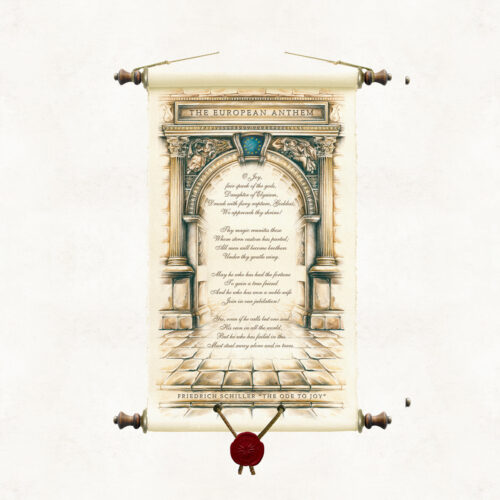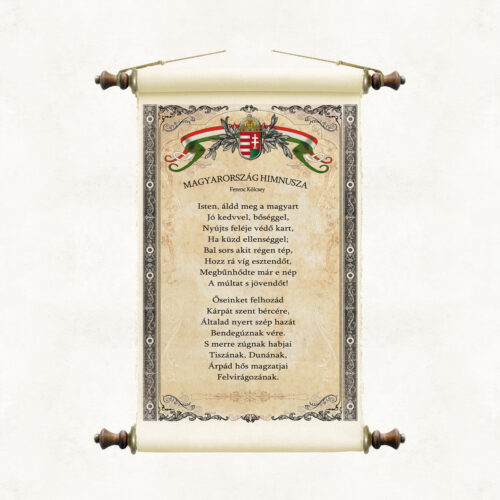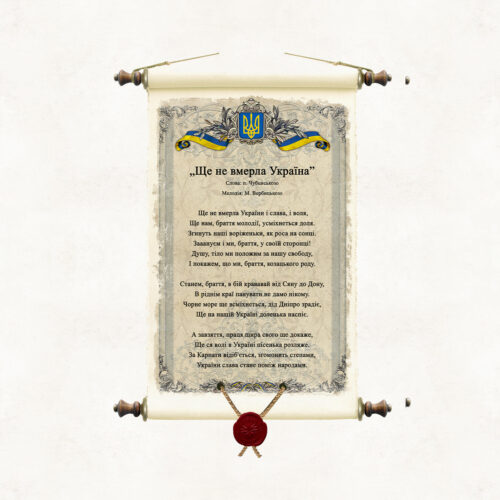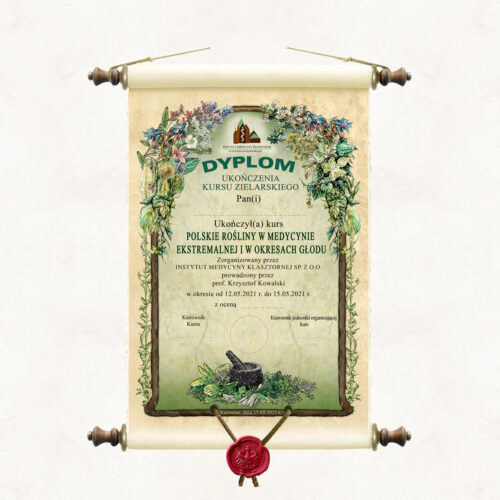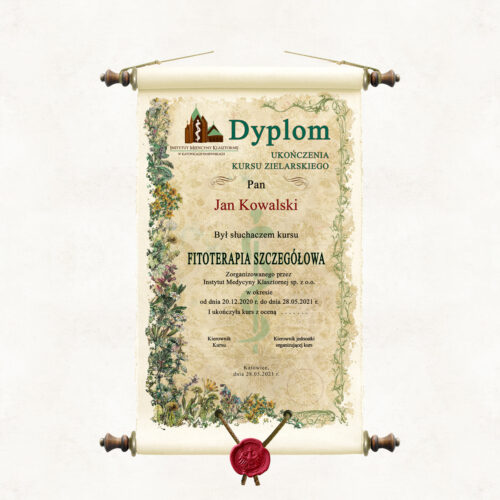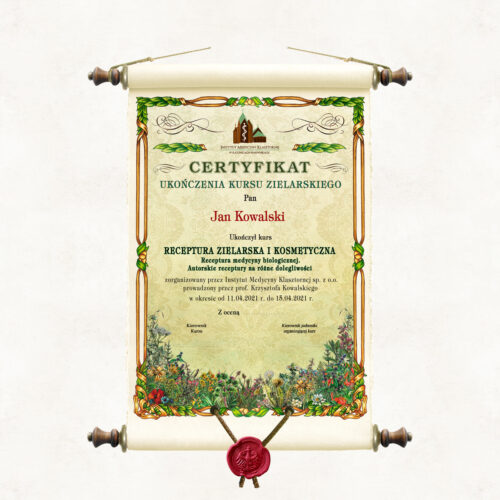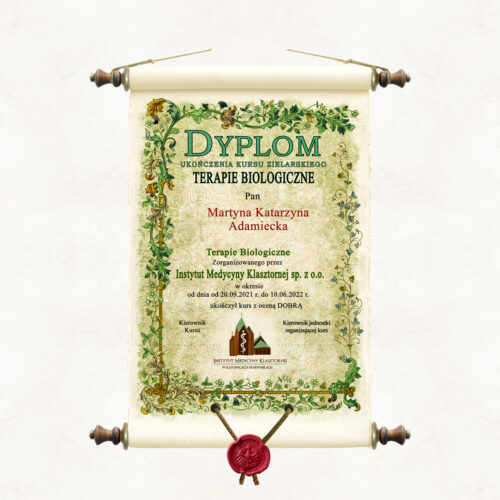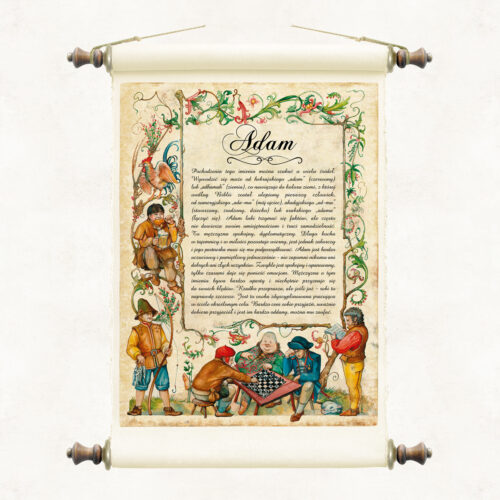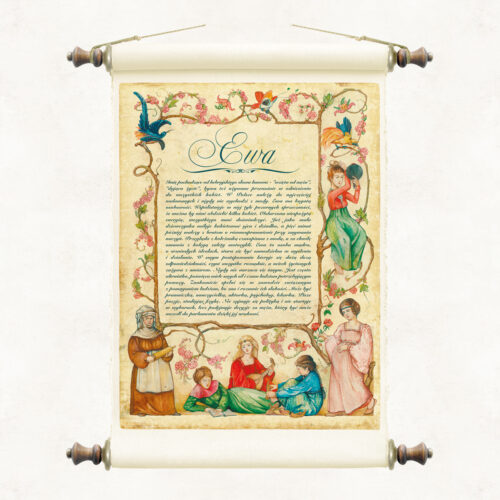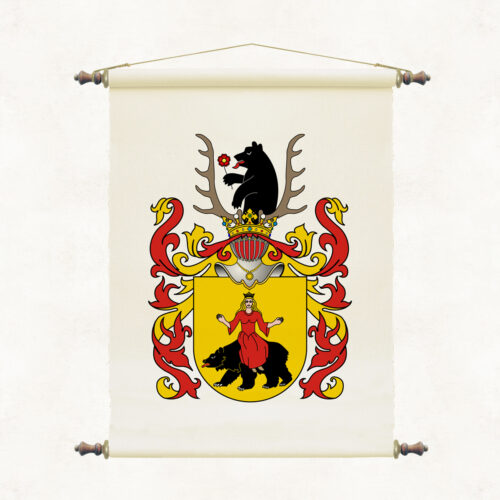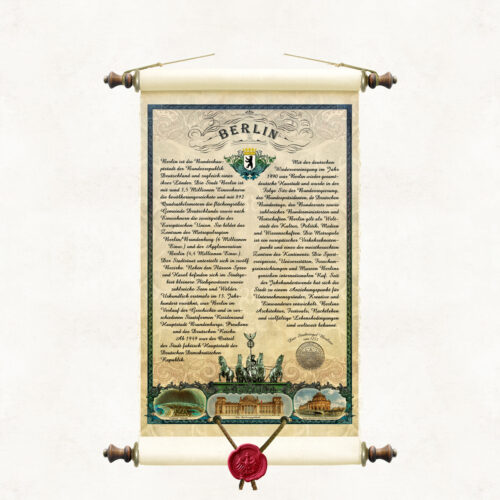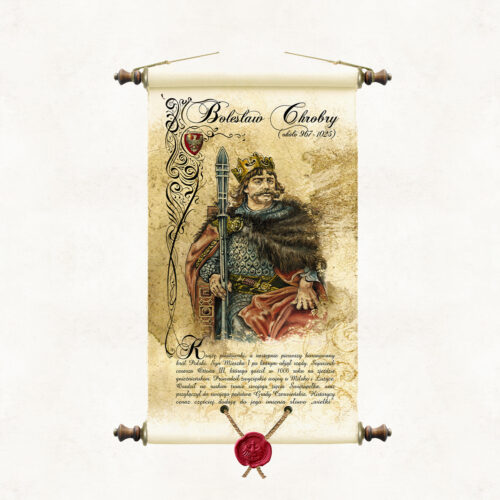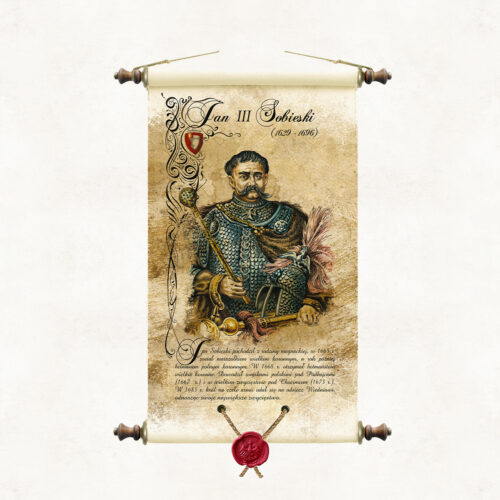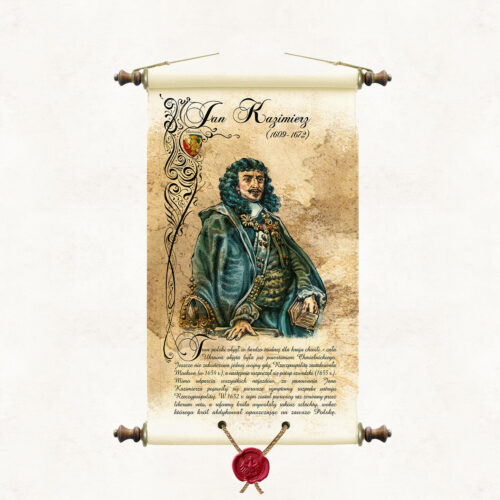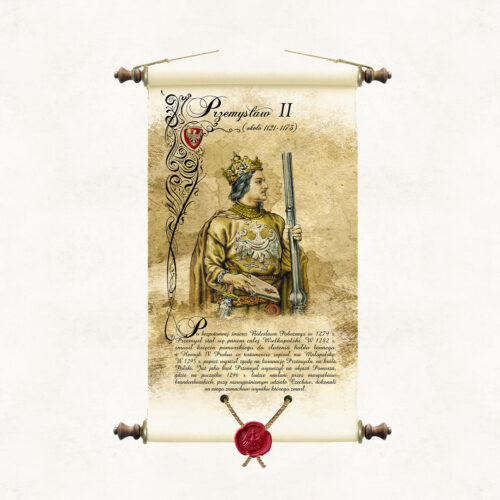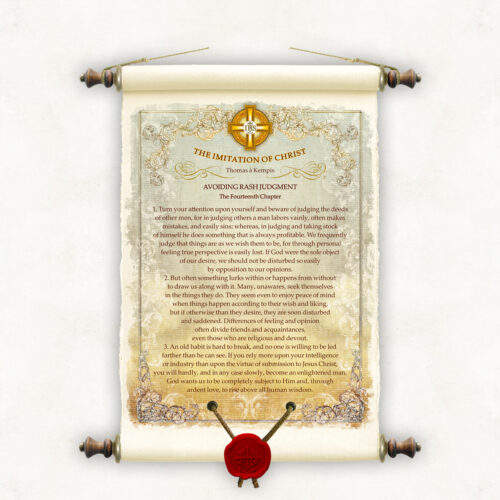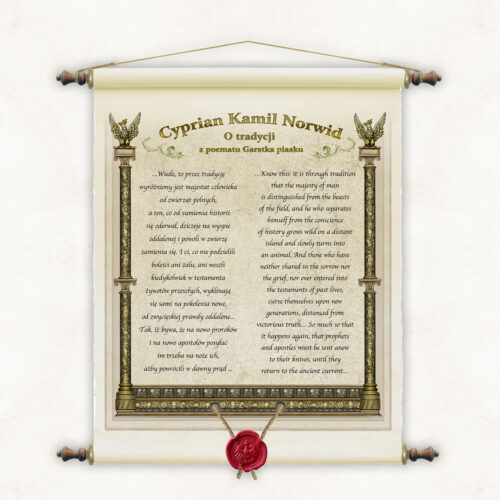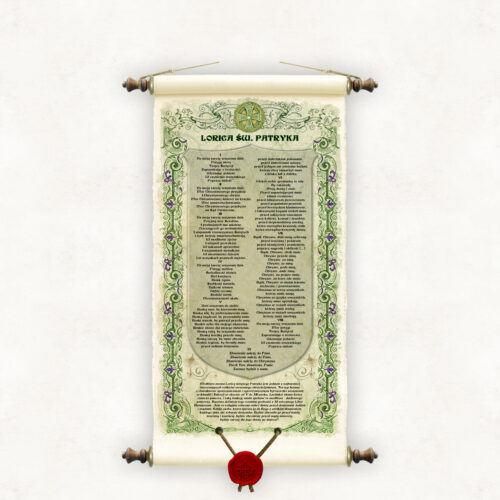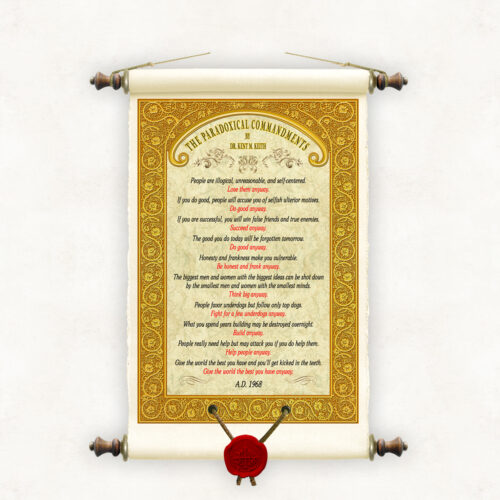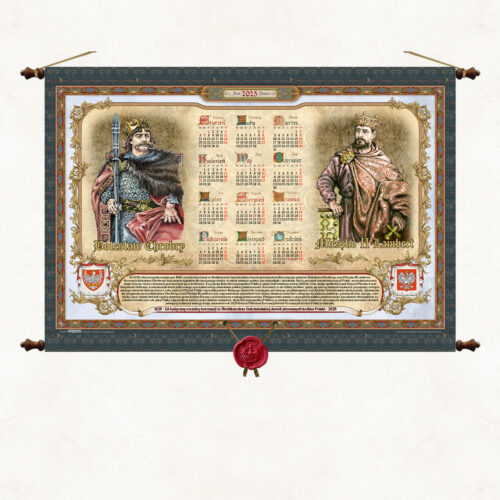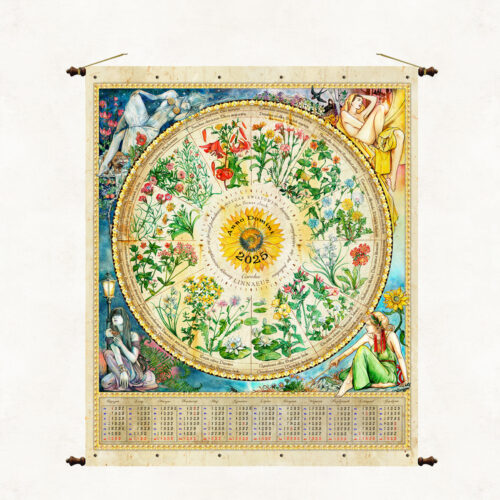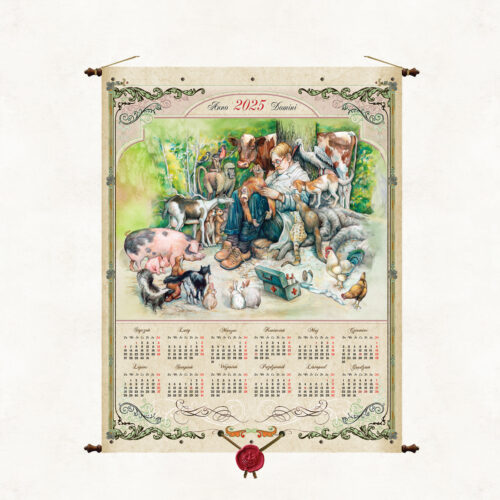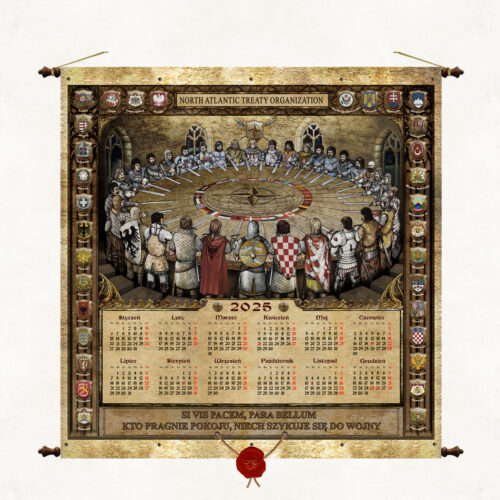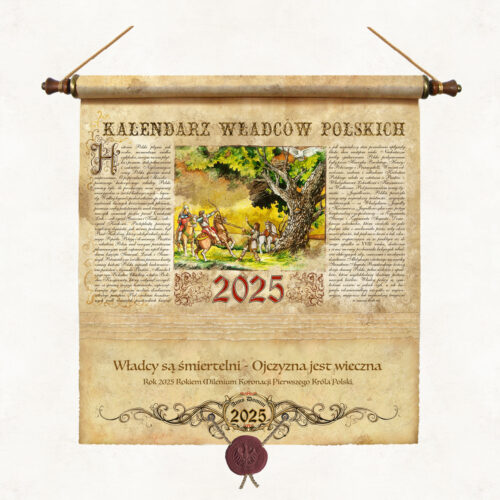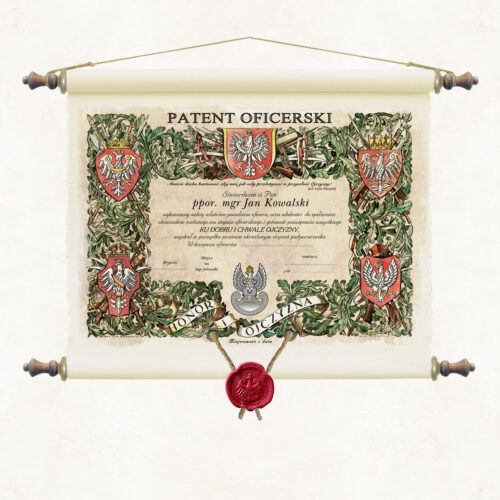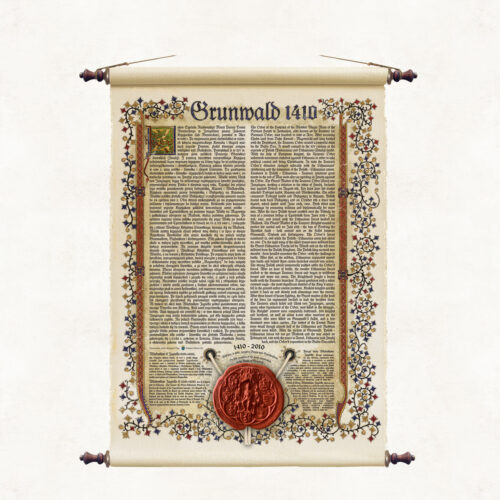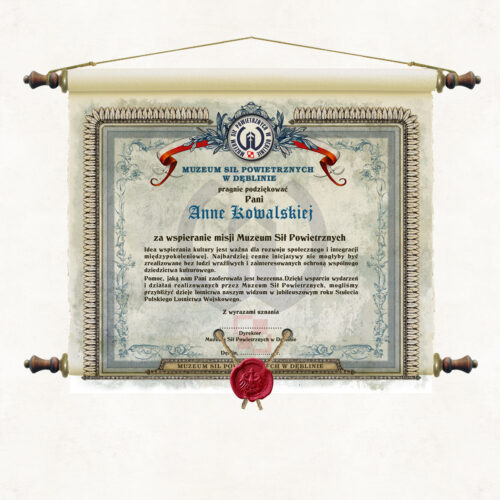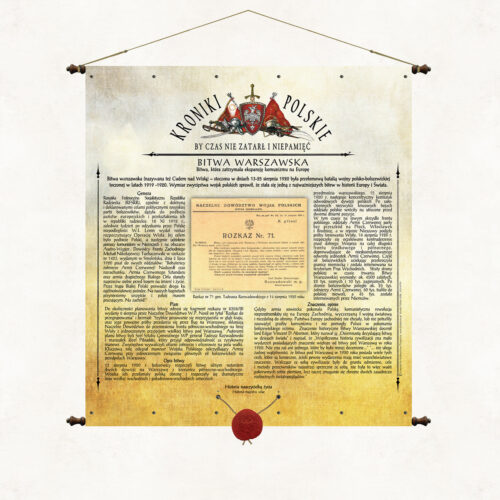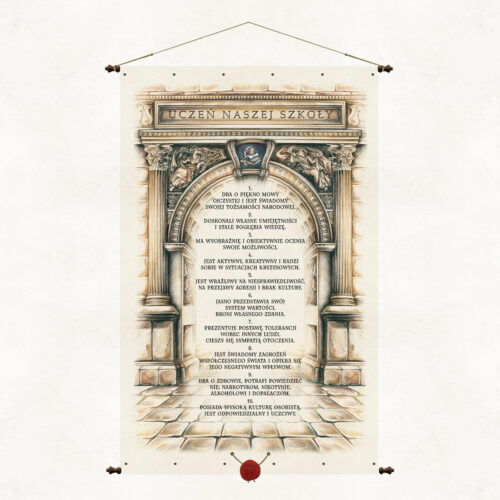-
We offer a graphic and literary lexicon of names in the form of stylised scrolls. The page shows examples of two namesakes, female and male, Adam and Eve. In our publishing resources we have a collection of namesakes relating to most of the popular names from our cultural background. When ordering a namesake, please select the gender and name of the lady or gentleman for whom it will be intended. There is a possibility to place a short dedication or a wish for the recipient on the name tag. This is an additionally charged service.
-
We offer a graphic and literary lexicon of names in the form of stylised scrolls. The page shows examples of two namesakes, female and male, Adam and Eve. In our publishing resources we have a collection of namesakes relating to most of the popular names from our cultural background. When ordering a namesake, please select the gender and name of the lady or gentleman for whom it will be intended. There is a possibility to place a short dedication or a wish for the recipient on the name tag. This is an additionally charged service.
-
We will make for you any coat of arms whose image is available in Wikipedia or heraldic publications. We present a sample visualisation of the Rawicz coat of arms on our shop's website.
-
WALL CHRONICLES IN THE FORM OF SCROLLS These are publications dedicated in particular to cities and local government units (municipalities, districts, provinces). Wall chronicles are an original promotional and commemorative gadget.
-
WALL CHRONICLES IN THE FORM OF SCROLLS These are publications dedicated in particular to cities and local government units (municipalities, districts, provinces). Wall chronicles are an original promotional and commemorative gadget.
-
A scroll with an image of King Casimir the Great, painted in watercolour by the artist of our publishing house, Marek Miha. The portrait is a colourful interpretation of drawings from the series Poczet królów i książąt polskich (A Selection of Polish Kings and Princes) made in pencil by Jan Matejko. KAZIMIERZ THE GREAT (1310 - 1370) The last of the Piast dynasty, king of Poland from 1333. Due to the construction of dozens of new cities, as well as the expansion or construction of several hundred new castles and fortresses, he was called ‘the one who found Poland wooden and left it brick’. The talented ruler was also famous for the small number of wars fought and an effective foreign policy. His reign consolidated the unification process of the Polish lands and brought Poland out of political isolation in Europe, after nearly two centuries of district disintegration.
-
Scroll with an image of King Ladislaus Jagiello, painted in watercolour by the artist of our publishing house, Marek Miha. The portrait is a colourful interpretation of the drawings from the cycle Poczet królów i książąt polskich executed in pencil by Jan Matejko. WŁADYSŁAW JAGIEŁŁO (1362 - 1434) Jagiełło, son of Olgierd, ruler of Lithuania, from 1377 Grand Duke of Lithuania. In 1385 he married Jadwiga of Anjou and concluded a personal union between Lithuania and Poland. As a result, he was baptised and named Ladislaus. In 1386, he became the Polish king. The victory won by Jogaila at Grunwald in 1410 over the Teutonic Order led to an increase in the importance of Poland and its monarch in the international arena, and the union with Lithuania was strengthened in 1413 with the Union of Horodela.
-
Scroll with an image of King Bolesław Chrobry, painted in watercolour by the artist of our publishing house, Marek Miha. The portrait is a colourful interpretation of drawings from the cycle Poczet królów i książąt polskich executed in pencil by Jan Matejko. BOLESŁAW CHROBRY (967 - 1025) The son of Mieszko I, the first crowned king of Poland. He was an ally of Emperor Otto III, whom he hosted in Gniezno in 1000. He waged victorious wars over Milsko and Lusatia. He organised missionary expeditions to Kyiv. He installed his son-in-law, Svyatopolk, on the throne of Kyiv, and recaptured the Chernivian lands previously occupied by Prince Vladimir of Kyiv, incorporating them into his own state. Historians are increasingly adding the word ‘Great’ to his name.
-
Scroll with an image of King Jan III Sobieski, painted in watercolour by the artist of our publishing house Marek Miha. The portrait is a colourful interpretation of drawings from the cycle Poczet królów i książąt polskich executed in pencil by Jan Matejko. JAN SOBIESKI (1629 - 1696) He came from a magnate family. In 1674, the nobility elected him king. Jan III Sobieski was an outstanding commander who achieved some of the greatest military successes of Polish arms, including the Battle of Chocim (1673) and the famous relief of Vienna (1683). He was also a great patron of culture and the arts. On the other hand, he did little in matters of foreign, domestic policy and economy. He did not stop the negative processes decaying the Polish state with increasing speed.
-
MIESZKO I (922-992) The first historical ruler of the Polish lands, the actual creator of the Polish statehood. A skilful politician and a talented leader. He fought battles for Western Pomerania and wars with Bohemia, conquering Silesia and Lesser Poland. By being baptised in 966, he strengthened the state, putting it on a par with the Christian countries of Europe. He established a Polish bishopric in Gniezno, and initiated the construction of numerous fortified towns and churches.
-
Scroll with an image of Prince Casimir the Restorer, painted in watercolour by the artist of our publishing house, Marek Miha. The portrait is a colourful interpretation of drawings from the series Poczet królów i książąt polskich (A Selection of Polish Kings and Princes) made in pencil by Jan Matejko. KAZIMIERZ THE RENEWER (1016 - 1058) Casimir Charles I, more commonly known as the Restorer, ruled Poland from 1039 to 1058. He failed to take power after his father Mieszko II, was exiled, and the country descended into chaos. In 1039, the Restorer returned to the country and, with the help of the German Emperor and a Ruthenian prince, gradually regained power, rebuilt the country, recreated the ecclesiastical metropolis and made Krakow the new capital. However, he was no longer able to regain the royal crown.
-
Scroll with an image of King Jan Kazimierz, painted in watercolour by the artist of our publishing house, Marek Miha. The portrait is a colourful interpretation of drawings from the series Poczet królów i książąt polskich (A Selection of Polish Kings and Princes) made in pencil by Jan Matejko. JAN KAZIMIERZ (1609 - 1672) He assumed the Polish throne at a very difficult moment for the country - the whole of Ukraine was covered by the Khmelnytsky uprising. One war had not yet ended when the Republic was attacked by Moscow (1654), followed by the Swedish deluge (1655). Despite repulsing all invasions, the first symptoms of the disintegration of the Commonwealth's political system appeared during the reign of Jan Kazimierz (the first Sejm in 1652, broken off by the liberum veto, and the nobility's rebellion). The King abdicated, leaving Poland forever.
-
Scroll with an image of Prince Przemysl II, painted in watercolour by the artist of our publishing house, Marek Miha. The portrait refers stylistically to the series of drawings Poczet królów i książąt polskich by Jan Matejko, in which the artist did not include an image of Prince Przemysl II. PRZEMYSŁ II After the heirless death of Boleslaw the Pious in 1279, Przemysl became lord of the whole of Greater Poland. In 1282, he forced the Duke of Pomerania to pay a fief tribute. Henry IV Probus bequeathed Malopolska to him in his will. In 1295, the Pope consented to the coronation of Przemysl, as king of Poland. In 1296, Przemysl set out on a tour of Pomerania, where he was assassinated, with the unexplained involvement of Czechs, by the Brandenburg margraves.
-
The Imitation of Christ (Latin: De imitatione Christi) - a popular book-guide to the Christian life written before 1427. The authorship of the work is attributed to Thomas à Kempis, although this is not definitively established. The book is a practical guide dedicated to Christians who, desiring salvation, walk in the footsteps of Christ. The Imitation of Christ is also the most popular ascetical work in the history of literature with a universal appeal beyond the Christian religion. The work consists of independent books and chapters containing instructions and wisdom on various aspects of the human quest for a worthy life. We offer you an original series of publications containing selected excerpts from this famous book. The form and charter of the work allow for random reading of individual chapters without direct reference to other parts of the work. Thus, we offer selected separate excerpts from the book, according to your tastes and needs. The themes and scrolls presented on our site are only an illustrative visualization of the series. To your order we will make any fragment of the book, provided that its size does not exceed a standardized page, that is, about 1800 characters with spaces and special characters. In selecting the text fragment you are interested in, we suggest using the study on the page : https://www.leaderu.com/cyber/books/imitation/imitation.html
-
The prayer called Saint Patrick's Breastplate is one of the most interesting relics of early Christianity. This type of hymn of an apotropaic and exorcistic nature was widely used in Ireland and Scotland between the 5th and 12th centuries. The prayer is meant to act as a spiritual armor. A specific definition of the term comes from the 11th-century Liber Hymnorum: “It is a religious protection of body and soul against demons, men and vices. Any person who sings it to God with great concentration, every day, will not see demons. It will protect him from every poison and envy, he will be protected from sudden death, and it will be a shield for his soul after death.”
-
The Paradoxical Commandments This piece was written by Kent M. Keith in 1968 as part of a booklet for student leaders. In the Polish version it is known under the title Mimo wszystko (Anyway). Its content inspired the name of the Anna Dymna Foundation - Mimo wszystko. The Paradoxical Commandments, contrary to their name, are not really paradoxical at all, they are in their essence commandments of love, and such a title would best convey the meaning of the piece. Their profound content and message are de facto a practical interpretation of the Hymn of Love from (1 Corinthians 13). They are indications of how to fill human life with love in order to live with dignity. After reading the commandments, after all, a fundamental question irresistibly imposes itself. In the name of what should we act so paradoxically? The answer is one and is found in the Bible, in the name of love, for God is love (1 John 4). The author does not give us this obvious answer directly. What's more, throughout the text he consciously and consistently does not refer to God even once, although we can feel His omnipresence in the text. The number of commandments referring to the Decalogue does not seem to be accidental either. This fact meant that the text cannot be classified as a publication from the ranks of naive religious instruction. The rest was done by the eternal human transcendent longing for truth, love, and the absolute. It made the Paradoxical Commandments immensely popular and, as the author himself writes, “For more than 50 years, the Paradoxical Commandments have circled the globe. They have been put on walls and refrigerator doors, featured in speeches and articles, preached from pulpits, and shared extensively on the web. They have been used by business leaders, military commanders, government officials, religious leaders, university presidents, social workers, teachers, rock stars, parents, coaches, and students. Mother Teresa thought the Paradoxical Commandments were important enough to put up on the wall of her children’s home in Calcutta.”
-
A publication dedicated to the thousandth anniversary of the coronation of the first two kings of Poland. In 2025, there will be a unique, 1000th anniversary of the coronation in the Archcathedral of Gniezno of the first two kings of our country: Bolesław the Brave and Mieszko II Lambert. The coronation of Bolesław the Brave was a clear signal to the world of that time that the young Polish state was independent and sovereign. It was the beginning of the growth of Poland's position on the medieval map of Europe, which transformed from a principality into a kingdom. On this occasion, the Sejm of the Republic of Poland pays tribute to the rulers who, 1000 years ago, being the heirs of Prince Mieszko I and Princess Dobrawa, continued the work of political and cultural strengthening of Polish statehood. These coronations would not have been possible if not for a number of important events, starting with the legendary foundation of Gniezno by Lech, through the Baptism of Poland, the martyrdom of Saint Adalbert and the establishment of the first archbishopric, and ending with the Congress of Gniezno. The commemoration of the accession to the throne of Bolesław the Brave and Mieszko II Lambert is a remembrance of all those who, gathered around the idea of the emerging Polish state, devoted time, energy, and sometimes even their lives, so that today we would be part of the proud group of European countries with a centuries-old tradition of statehood. Cultivating the memory of the beginnings of Polish statehood is our duty, and it is also a testimony to the role that Poland has played in the world over the past millennium. The Sejm of the Republic of Poland, in recognition of the significance of these events, resulting in the establishment of the first dynasty to rule in the history of our country, establishes the year 2025 as the Millennium Year of the Coronation of the First Two Kings of Poland in Gniezno.
-
A charming composition of flowers and symbols creating a stylized clock face painted by the famous Silesian artist and illustrator Jarek Nocoń, shows the most important species of plants used in creating a natural flower clock. In the corners we placed allegorical female figures symbolizing the seasons. A flower clock is an original idea of using the natural properties of plants to measure time. This unconventional timepiece is based on the observation of the life cycle of flowers, which open and close their petals at specific times of the day. This idea uses the circadian rhythms of plants, which are naturally synchronized with the rhythms of the environment, mainly with changes in sunlight. The idea of creating a flower clock comes from the observation of the natural behavior of plants by the famous botanist, Carl Linnaeus. In the 18th century, Linnaeus noticed that different species of plants open their flowers at fixed and predictable times of the day, which inspired him to use these phenomena in practice to measure time.
-
A publication dedicated to veterinarians and all those sensitive to animal suffering. In an allegorical illustration, we have presented a veterinarian during an operation on a sick animal. Around the veterinarian, various species of animals (potential patients) are gathered, experiencing with compassion this painful situation for the monkey.
-
A publication dedicated to soldiers and all defenders of freedom and peace gathered around the North Atlantic Treaty Organization (NATO). In an allegorical illustration referring to the Arthurian legend of the Knights of the Round Table, we have shown representatives of NATO member states stylized as knights. The motto of the calendar is a Latin proverb, paraphrased from the prologue to the work On the Art of War by Vegetius, a Roman historian from the 4th century AD Si vis pacem, para bellum – “If you want peace, prepare for war”. In the cartouches forming the frame of the image, we have placed the emblems of NATO countries.
-
The rulers are mortal - The homeland is eternal 14-page calendar of the Rulers of Poland – Millennium souvenir of the coronation of the first king of Poland, Bolesław Chrobry This is an exceptional publication, its form, content and the idea it serves make it deserve the title of a millennium souvenir in every respect. This great anniversary has become an opportunity for us to present the topic of Polish rulers in a comprehensive form in the form of a unique calendar – album. Following the drawings from the Collection of Polish Kings and Princes by Jan Matejko, we have created our own original collection of 48 colour portraits of Polish rulers, supplemented with figures that Master Matejko did not draw. Each month's page features images of four historical figures with short biographies. The year 2025 will mark the thousandth anniversary of the coronation in Gniezno of two Polish kings, Bolesław the Brave and his son Mieszko II Lambert. The coronation of the first Polish king, Bolesław the Brave, took place in the Gniezno cathedral most likely on Easter, which then fell on April 18. Two months later, Chrobry died and his son Mieszko II took over the inheritance. The coronation ceremony took place the same year on Christmas, also in Gniezno.
-
Diploma confirming appointment to the first officer rank in the Polish Army. Our offer is a modernized, color version of a pre-war document called officer's patent, made according to a monochromatic design by Prof. Jan Wojnarski. Appointment to the rank of officer is part of the military ceremonial, referring to the medieval tradition of knighting - the fitting of a knight. The rank is conferred in Poland by the President of the Republic of Poland at the request of the Minister of National Defense. . The original old patent was signed by the Minister of Military Affairs and the President of the Republic, and during the lifetime of Jozef Pilsudski it was also signed by the Marshal himself. The text of the pre-war patent was as follows: At the request of the Minister of Military Affairs, stating that Mr. (Name of officer) has the military preparation and qualities appropriate to the vocation of an officer, Translated with DeepL.com (free version)
-
Chronicle of the Battle of Grunwald with a unique copy of the majestic seal of King Ladislaus Jagiello.
-
Edition in the form of a stylised scroll with a wax seal suspended on strings. It is printed on decorative paper, similar in texture and properties to the handmade papers used in former times. An additional characteristic of the publication are the jagged edges of the sheet, which are stylistically reminiscent of old incunabula affected by the teeth of time. As with all our wall publications, the paper is coated with a matt laminate on both sides, which strengthens it and protects it from moisture and dust. In addition, this treatment makes the scroll similar to the original parchment. The sheet is wound on wooden rollers topped with knobs with metal fittings. The overall design is reminiscent of Roman scripture scrolls or Jewish torah. Author's binding by Pergamena Publishing House with decorative hanging string.
-
Polish Chronicles – So that time does not erase and oblivion
Polish Chronicles – is a series of boards devoted to important events in the history of Poland. The Battle of Warsaw (also called the Miracle on the Vistula) fought on August 13-25, 1920 was a breakthrough battle of the Polish-Bolshevik war fought in the years 1919-1920. The scale of the victory of the Polish forces made it one of the most important battles in the history of Europe and the world -
The educational board Student of Our School presents patterns of good features, attitudes and behaviors of students.
-
An educational board dedicated to the young generation, for whom the tragic period of Martial Law is fortunately only an inexperienced episode in the history of our country. It presents the most important events of that time in a clear and suggestive way.

